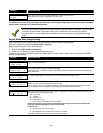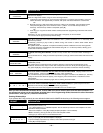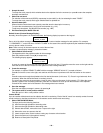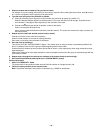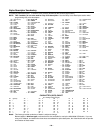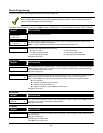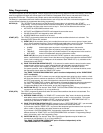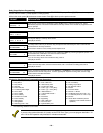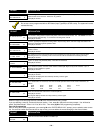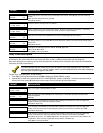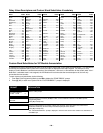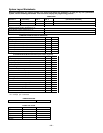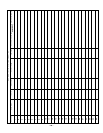
– 22 –
Relay Programming
The system supports up to 8 relay outputs. Relays can be used to perform many different functions and actions. Each relay
must be programmed to begin one of three types of ACTIONS at a designated START event, and end that ACTION at a
designated STOP event. The options and prompts used to start and stop these devices are described below
The letter(s) in parentheses after each function described below, such as (A) after ACTION, are those that appear in the
various summary displays of programmed data during programming.
ACTION (A) The "ACTION" of the device is how the device will respond when it is activated by the "START"
programming. You may want the device to activate momentarily, to pulse on and off continuously, or to
remain activated until some other event occurs to stop it. There are five different action choices:
• ACTIVATE for 2 SECONDS and then reset.
• ACTIVATE and REMAIN ACTIVATED until stopped by some other event.
• PULSE ON and OFF until stopped by some other event.
• NO RESPONSE when the device is not used.
START (STT) The "START" programming determines when and under what conditions the device is activated. The
following START options are available:
1) EVENT (EV) is the condition (alarm, fault, trouble) that must occur to a zone or group of zones (zone
list) in order to activate the device. These conditions apply only when a zone list is used. The different
choices for "EVENT" are listed below and in “Programming Relays” later in this section.
• ALARM Action begins upon any alarm in an assigned zone in the zone list.
• FAULT Action begins upon any opening of an assigned zone in the zone list.
• TROUBLE Action begins upon any trouble condition in an assigned zone in the zone list.
• NOT USED Action is not dependent upon one of the above events.
ZONE LIST (ZL) is a group of zones to which the “EVENT” applies in order to activate a particular
device. Note that there are a total of 4 zone lists that can be programmed; when the selected EVENT
(alarm, fault or trouble) occurs in any zone in the selected “Start” ZONE LIST (1-4), activation of the
selected device will START.
3) ZONE TYPE/SYSTEM OPERATION (ZT). If all zones to be used to start the device have the same
response type, and there are no other zones of this type that are not to activate this device, then
“ZONE TYPE” may be used instead of a "ZONE LIST" and "EVENT” to activate the device.
If a system operation, such as “DISARMING” or “ANY FIRE ALARM,” is to activate the device, enter
the appropriate choice under the “ZONE TYPE” option.
The “ZONE TYPE/SYSTEM OPERATION” option functions independently of the “EVENT/ZONE
LIST” combination.
If a specific "ZONE TYPE" is chosen, any zone of that response type going into alarm, trouble, or fault
will cause the device to activate as selected in "ACTION.” If the same “ZONE TYPE” is also chosen for
the STOP programming, any zone of that type that restores will de-activate the device.
If a "SYSTEM OPERATION" is chosen, that operation will cause the device to activate as selected in
"ACTION.” The different choices for "ZONE TYPE" and "SYSTEM OPERATION" are listed in
“Programming Relays” later in this section, and on the Programming Form.
4) PARTITION NO. (P). The device's "Start" ZONE TYPE/SYSTEM OPERATION may be limited to an
occurrence on one partition (1-2), or any partition (0).
STOP (STP):
The "STOP" programming determines when and under what conditions the device is de-activated. The
following options are available:
1). RESTORE ZONE LIST (ZL). If a "ZONE LIST" is used as the “Stop” event, the device de-activates
when all the zones in that list restore from a previous fault, trouble, or alarm condition. This occurs
regardless of what is programmed to "START" the device; therefore, a "RESTORE ZONE LIST" is
normally only used when a "ZONE LIST" is used to start the device.
2). ZONE TYPE/SYSTEM OPERATION (ZT). Instead of using a "RESTORE ZONE LIST," you can select
a specific zone (response) type or system operation action to de-activate the device.
If you choose a specific "ZONE TYPE," any zone of that response type that restores from a previous
alarm, trouble, or fault condition will cause the device to de-activate.
If you choose a "SYSTEM OPERATION," that operation causes the device to de-activate. The
different choices for "ZONE TYPE" and "SYSTEM OPERATION" are listed in “Programming Relays”
later in this section, and in the Programming Form.
3) PARTITION NO. (P). The device's "Stop" Zone Type/System Operation may be limited to an
occurrence on one partition (1-2), or on any partition (0).
The “ZONE TYPE/SYSTEM OPERATION” option functions independently of the
“RESTORE/ZONE LIST” combination.



